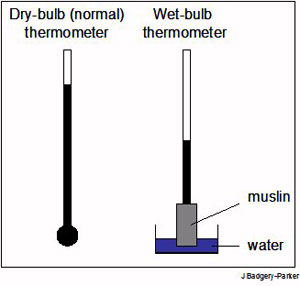
Evaporative cooling in greenhouses
Evaporative cooling uses the natural relationship between relative humidity, water and air temperature. When water is evaporated it has a cooling effect. Humidity is also increased and the vapour pressure deficit is reduced. Evaporative cooling is most effective in southern coastal areas and most inland areas of Australia.

Air temperature can be measured as either a dry bulb temperature or a wet bulb. The wet bulb temperature, gives an indication of what temperature air can be cooled to with evaporative cooling. Wet bulb temperature is measured using a thermometer with a wet sleeve or wick around it. Air passing over the thermometer and the water on the sleeve evaporates and cools the thermometer, so that it is reading less than the temperature read by a normal (dry) thermometer.
The amount of cooling that can be achieved from evaporative cooling systems is dependent on how much water can be evaporated so is related the amount of water already in the air. This is relative humidity. Table 1 shows the temperature to which air can be potentially cooled. As can be seen from the table, evaporative cooling is most effective when the relative humidity is below 60%.
| Air temp (°C) (dry bulb) | Potential cooling effect (difference between dry bulb and wet bulb temperature) In degrees (°C) at different levels of relative humidity (%) | |||||||||||||||||||
|---|---|---|---|---|---|---|---|---|---|---|---|---|---|---|---|---|---|---|---|---|
| 0.5 | 1.0 | 1.5 | 2.0 | 2.5 | 3.0 | 3.5 | 4.0 | 4.5 | 5.0 | 5.5 | 6.0 | 6.5 | 7.0 | 7.5 | 8.0 | 8.5 | 9.0 | 9.5 | 10.0 | |
| 10 | 94% | 88% | 82% | 77% | 71% | 65% | 60% | 54% | 49% | 44% | 39% | 34% | 29% | 24% | 19% | 14% | 9% | 5% | ||
| 15 | 95% | 90% | 85% | 80% | 75% | 71% | 66% | 61% | 57% | 52% | 48% | 44% | 40% | 36% | 31% | 27% | 24% | 20% | 16% | 12% |
| 20 | 96% | 91% | 87% | 83% | 78% | 74% | 70% | 66% | 62% | 59% | 55% | 51% | 48% | 44% | 41% | 37% | 34% | 30% | 27% | 24% |
| 25 | 96% | 92% | 88% | 84% | 81% | 77% | 74% | 70% | 67% | 63% | 60% | 57% | 54% | 50% | 47% | 44% | 41% | 38% | 36% | 33% |
| 30 | 96% | 93% | 89% | 86% | 83% | 79% | 76% | 73% | 70% | 67% | 64% | 61% | 58% | 55% | 52% | 50% | 47% | 44% | 42% | 39% |
| 35 | 97% | 93% | 90% | 87% | 84% | 81% | 78% | 75% | 72% | 70% | 67% | 64% | 61% | 59% | 56% | 54% | 51% | 49% | 47% | 44% |
| 40 | 97% | 94% | 91% | 88% | 85% | 82% | 80% | 77% | 74% | 72% | 69% | 67% | 64% | 62% | 60% | 57% | 55% | 53% | 51% | 48% |
Fan and pad systems
Fan and pad systems combine two pieces of equipment. An exhaust fan is located at one end of the greenhouse and a porous pad is built into the wall of the structure at the opposite end. A pump circulates water over and through the pad. When the fan is in operation, it pulls air from outside the structure, through the evaporative pad, into the greenhouse. The air, passing through and over the wet pad evaporates some of the water and is cooled. As a result, cool air is drawn into the greenhouse to replace the hot air expelled by the fan.
These systems are quite effective for cooling but are relatively expensive to install and maintain. A disadvantage of the fan and pad system is that it tends to create a significant temperature gradient from one end of the greenhouse to the other (warmest at the fan end and coolest at the pad end) which can affect crop uniformity and make management more difficult. Under extreme conditions which demand a lot of cooling, the air movement through the greenhouse generated by exhaust fans may damage plants.
Fogging systems
Fogging systems are a fairly effective and uniform method of greenhouse cooling and provide a reasonable increase in relative humidity in a greenhouse. On a hot day, a cooling effect of up to 10oC can be achieved. Fogging systems produce very small droplets of water in the range of 10-20 microns which are suspended in the air and evaporate before they have time to fall on to the crop canopy.
Fogging line pressure and fogging nozzles need to be properly maintained. A poorly maintained system may not provide sufficient cooling or could result in wetting of leaves and fruit. This can lead to reduced product quality and an increased incidence of pests and diseases.
Misting systems
Misting systems can be used to deliver a fine spray of water into the greenhouse air space to provide some relief during very hot and/or dry conditions. Most misting systems operate at a pressure of between around 250kPa and 300kPa. The water droplets are typically in the range of 100 to 200 microns. This sized droplet is too large to be completely evaporated and so it falls quickly, wetting the crop and the greenhouse floor.
While misting systems can have a cooling benefit, a wet canopy can lead to an increase in diseases and fruit damage. A wet floor can pose a safety risk to people in the greenhouse.

